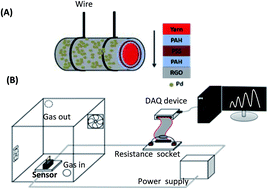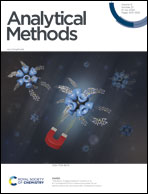H2-gas sensing and discriminating actions of a single-yarn sensor based on a Pd/GO multilayered thin film using FFT
Abstract
A single-yarn H2-gas sensor was fabricated by self-assembling poly(allylamine hydrochloride) (PAH), poly(styrenesulfonic acid) sodium salt (PSS), graphene oxide (GO) and Pd-based complex thin films layer-by-layer on a single-yarn and then in situ reducing the Pd-based complex to a Pd/GO/PAH/PSS/PAH multilayered thin film. The H2-gas sensing properties, effect of bending and humidity influence on this sensor were investigated. The sensor exhibited a high response and good linearity over the range of 1000 to 10 000 ppm of H2 gas. The response of the sensor decreased under both conditions of a bending angle up to 20° and ambient humidity above 50% RH. A fast Fourier transform (FFT) analyzer was employed to disperse the signals of the sensor under the conditions of bending and ambient humidity influence in the presence of H2 gas. Differentiation of the amplitude of FFT from the first-order to second-order frequency spectra effectively increased the discrimination capability of the sensor under the conditions of bending and humidity influence.



 Please wait while we load your content...
Please wait while we load your content...